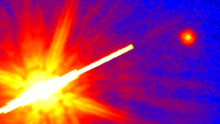Gliese 105
| Observation data Epoch J2000 Equinox J2000 | |
|---|---|
| Constellation | Cetus |
| Right ascension | A: 02h 36m 04.89s[1] B: 02h 36m 15.0s C: 02h 35m 58.8s |
| Declination | A: +06° 53′ 12.7″[1] B: +06° 52′ 18″ C: +06° 52′ 00″ |
| Apparent magnitude (V) | 5.82/11.66/16.9 |
| Characteristics | |
| Spectral type | K3 V/M3.5 Vn/M7 V |
| U−B color index | 0.81/1.12 |
| B−V color index | 0.97/1.60 |
| Variable type | None/BY Draconis |
| Astrometry | |
| Radial velocity (Rv) | 25.7 km/s |
| Proper motion (μ) | RA: 1807.78 ± 0.89[1] mas/yr Dec.: 1444.02 ± 0.40[1] mas/yr |
| Parallax (π) | 139.27 ± 0.45[1] mas |
| Distance | 23.42 ± 0.08 ly (7.18 ± 0.02 pc) |
| Absolute magnitude (MV) | 6.49/12.34/17.58 |
| Details | |
| Mass | 0.81/0.21/0.08 M☉ |
| Radius | 0.650 ± 0.053[2]/0.28 R☉ |
| Luminosity (bolometric) | 0.29/ ? L☉ |
| Luminosity (visual, LV) | 0.22/0.001/0.0000075 L☉ |
| Temperature | 4,841[3] K |
| Metallicity | 85.11%[3]/ ? Z☉ |
| Rotation | ? |
| Age | 4.8-6.6 (Sun=4.6) ×109 years |
| Other designations | |
| Database references | |
| SIMBAD | data |

Gliese 105 (also known as 268 G. Ceti) is a triple star system in the constellation of Cetus. It is located relatively near the Sun at an estimated distance of less than 24 light years,[1] but even the brightest component is too faint to see directly with the unaided eye. No planets have yet been detected around any of the stars in this system.
The companion star B has a common proper motion with A, and the two have an estimated separation of 1,200 AUs. It is a BY Draconis variable star that has been given the designation "BX Ceti".
The third companion C lies much closer to A, presently at a distance of approximately 24 AU. The pair A-C have an estimated orbital period of 61 years. C's orbit is estimated to have a high eccentricity of around 0.75 and a semi-major axis of 15 AU,[4] giving an aphelion of 26.25 AU and a perihelion of just 3.75 AU. Component C is a relatively minuscule star that lies at the low end of the mass range needed to achieve nuclear fusion.
From the surface of a theoretical Earth-like planet at 0.55 AU distance from Gliese 105 A, near the inner edge of that star's habitable zone, component C at perihelion would only ever get about half as bright as the full moon does, despite it being a star, and at aphelion it would appear about as bright as Venus becoming barely even visible to the naked eye in the daytime.
References
- 1 2 3 4 5 6 van Leeuwen, F. (2007). "Validation of the new Hipparcos reduction". Astronomy and Astrophysics. 474 (2): 653–664. arXiv:0708.1752
 . Bibcode:2007A&A...474..653V. doi:10.1051/0004-6361:20078357. Vizier catalog entry
. Bibcode:2007A&A...474..653V. doi:10.1051/0004-6361:20078357. Vizier catalog entry - ↑ van Belle, Gerard T.; von Braun, Kaspar (2009). "Directly Determined Linear Radii and Effective Temperatures of Exoplanet Host Stars". The Astrophysical Journal. 694 (2): 1085–1098. arXiv:0901.1206
 . Bibcode:2009ApJ...694.1085V. doi:10.1088/0004-637X/694/2/1085.
. Bibcode:2009ApJ...694.1085V. doi:10.1088/0004-637X/694/2/1085. - 1 2 Soubiran, C.; Bienaymé, O.; Mishenina, T. V.; Kovtyukh, V. V. (2008). "Vertical distribution of Galactic disk stars. IV. AMR and AVR from clump giants". Astronomy and Astrophysics. 480 (1): 91–101. arXiv:0712.1370
 . Bibcode:2008A&A...480...91S. doi:10.1051/0004-6361:20078788.
. Bibcode:2008A&A...480...91S. doi:10.1051/0004-6361:20078788. - ↑ Golimowski, David A.; et al. (2000). "The Very Low Mass Component of the Gliese 105 System". The Astronomical Journal. 120 (4): 2082–2088. arXiv:astro-ph/0006230
 . Bibcode:2000AJ....120.2082G. doi:10.1086/301567.
. Bibcode:2000AJ....120.2082G. doi:10.1086/301567.
External links
- Gliese 105 / HR 753 ABC SolStation entry.
- Hubble Spies a Really Cool Star
- Gliese 105